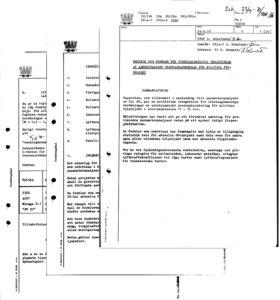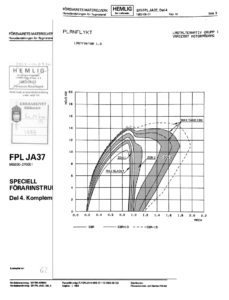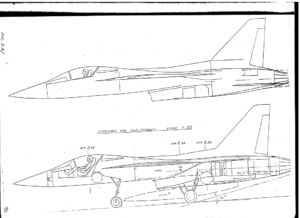About

SAAB's conceptual design guide for fighter aircraft from the 1970's.

JA37 Viggen flight envelope from the "SFI" flight manual.

The conceptual KIF-83 fighter, sporting its charecteristic dorsal air intake.

Royal Institute of Technology (RIT) in Stockholm.
Origins
Much of the content on this web site can be traced back to a study project I did already in 1984 together with an officer in the Norwegian Air Force when we were both studying for our Master’s degrees in aeronautical engineering at the Royal Institute of Technology (RIT) in Stockholm. As part of a course about aircraft systemization, our class was tasked to do a feasibility study of a hypothetical delta winged jet, the KIF-83, and while other groups were looking into the systems design for the fuel, landing gear, structures, engine etc, my friend Knut S and I volunteered to do the performance analysis to generate plots like the JA37 flight envelope above. The course was led by assistant Professor Bengt Andersson, who only worked part time at the RIT since his main line of work was at SAAB’s conceptual designs department for military aircraft in Linköping. He was therefore very much the man for the job, and he provided us not only with great input and encouragement, but also with a very useful SAAB guideline document for assessing the performance of conceptual aircraft. In the mid 1980’s, conceptual design work at SAAB was still mostly done using pen and paper, and this was also how Knut S and I started off. However, it soon became clear to me that doing it this way would take an awful lot of time since every single data point in the performance envelope had to be calculated by hand, albeit aided by my (for its time!) cutting edge HP-15C calculator.

Front & rear views of Ridder's competing JAS39 Gripen design.

Side & section views of Ridder's JAS39 Gripen alternative.

Top & bottom views of Ridder's JAS39 Gripen alternative.

English translation of the Fw-190 A-8 Flugzeug Handbuch.
The simulation program
However, since I was at the same time also taking a course in computer programming, I came up with the bright idea (at least I thought so at the time!) to “automate” the tedious task of calculating every single data point by instead using “modern” computing power. But since this was before the advent of PC’s, I had to do it all on the RIT’s mainframe computer using a now extinct programming language called Simula. Long story short, the work turned out to be far more extensive than I had anticipated, and had it been only for that particular project, we would probably have been far better off doing the calculations by hand in the first place. However, gaining a Master of Science degree involves doing a thesis, and this got me thinking that why let all this work go to waste? Maybe I can do something with it? I therefore polished my arguments and presented my case to Professor Fritz Hjelte at the RIT’s Aerodynamics Department, who thankfully agreed to sponsor a thesis with the title “The influence of external stores on fighter jet performance” which as the name implies, involved studying the effects of external stores like fuel tanks, bombs and missiles on the flight performance of a typical jet fighter aircraft. As my base aircraft, I chose the very neat looking (See the figures above!) 50 degree swept wing design Professor Sven-Olof Ridder of the RIT a few years earlier on had tried (alas unsuccessfully since this aircraft would have had better turn capabilities without having to be aerodynamically unstable!) to convince SAAB was a better a option than the canard design they finally settled on for the JAS39 Gripen.
Resurrection
Following my graduation from the RIT in 1986, the Simula program lay dormant for many years until the early 2000’s when flight simulators like Microsoft Combat Flight simulator, European Air War and IL-2 Sturmovik started to pique my interest. However, it soon became clear that while these simulators certainly were entertaining, they were still in their early gestations and lacking in flight performance fidelity, since it was apparent that some numbers simply did not dovetail with historical data. This got me thinking that maybe I could dig up my old thesis and modify it to see if I could get a better understanding of how these aircraft truly performed and perhaps provide some constructive feedback to the developers as well? I therefore ported my old jet centric Simula code to the C++ language and added extensions to handle propeller driven aircraft, and started modelling different WW2 era aircraft. I began with the Fw-190A8 for which there was solid data for both performance and the engine, and used this to tune the overall model. I then added various versions of the Spitfire, Me-109, Fw-190, Mustang, Thunderbolt, Tempest, LAGG, Yak, La-5 and Lightning etc. Over the years since the mid 2000’s, I have since updated the software continuously and been active in various internet forums posting simulations results under the pseudonyms Holtzauge & Pilum, and for those wishing to form an own opinion about the level of accuracy in the simulations, I think taking a look at what has been posted over the years gives a good indication of how well the overall simulation model stands up to scrutiny. And I think it’s fair to say that changes to the most popular flight simulations have moved in the direction of my simulation results rather that the other way around. As an example, I was posting data on dive performance taking compressibility effects into account long before this was incorporated into any of the leading WW2 aircraft simulations of the time. However, models can always be improved, and if someone finds simulation results that I have posted that appear doubtful, please let me know by contacting me via the form that can be found under the Contact tab.
Most recent developments
In 2014 I added the capability to also model missile kinematics. This was in part driven by how some air-air missiles were modeled in the DCS simulator, the veracity of which I wanted to check. And some simulation results have been posted in the DCS forum. In addition, there is now a new paper added in the Documents section which analyses a missile intercept scenario. The latest major addition of functionality was the ability to also model WW1 aircraft. This work was started in 2019, yet again triggered by a flight simulator, the Il-2 Sturmovik’s Flying Circus series, and a curiosity about how these wood and fabric aircraft performed in real life. During the course of comparing simulation results for these aircraft, I discovered some interesting things that to some extent went against the grain of common wisdom, and which in turn inspired me to write the book WW1 Aircraft Performance which can be ordered via the link found under the Books tab above. Parts of the information contained in this book can be found in the two papers available as free downloads under the tab Documents above. I hope you will find these two pdf’s interesting and that they will inspire you to read the book as well!
Anders F. Jonsson
Stockholm, Sweden, the 7th November 2023